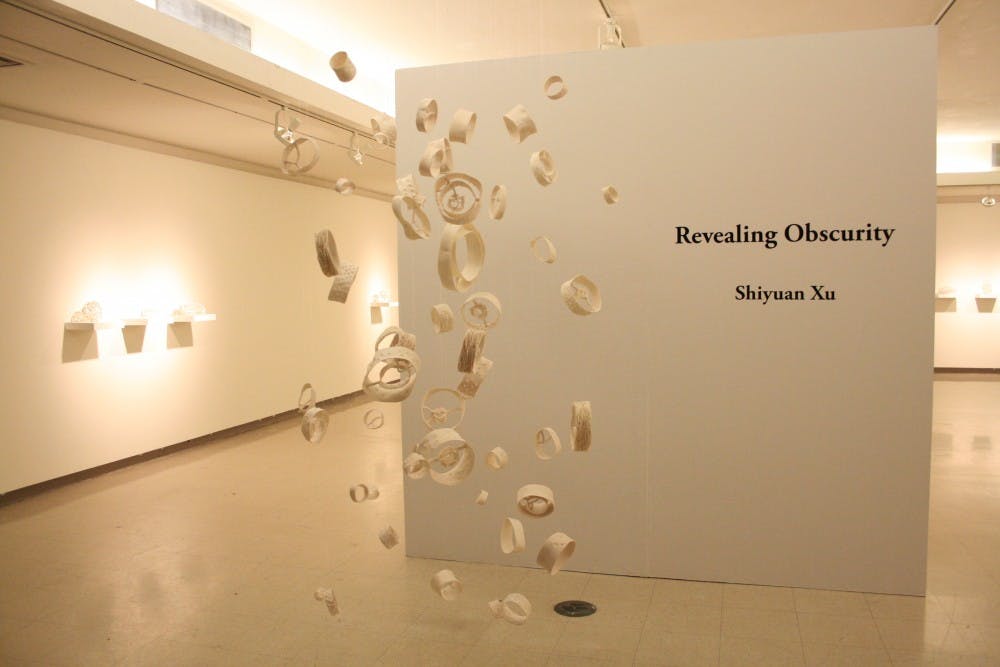In a stage of life where young adults are persistently reminded to keep their eyes on the big picture, it's not often that they stop to ponder and appreciate the tiny facets that comprise the whole.
Masters ceramics senior Shiyuan Xu is using her senior thesis exhibition, "Revealing Obscurity," to push people out of their tendency to overlook the building blocks of life and encourage them to observe the microscopic matter that makes the world go round.
Xu said her work is comprised of many porcelain-based sculptures as well as some unconventional sketches, all of which she feels present microorganisms in a powerful, intriguing new way.
"The porcelain has a very fragile, pure form," she said. "It's connected to the organisms because they kind of have relationships to the fragile moment. ... I'm interested in the structure and tiny things, but they have a very complex form and very beautiful moments."
In addition to the scientific moments expressed through observation of microorganisms, Xu also used various glazing techniques to represent the growth of organisms from the inside out.
Her tendency to perceive the details of the microorganisms as moments contributes to the feeling of her exhibition as a story and personal experience in itself.
Xu said the entry point to her interest in an artistic reconstruction of microorganisms stemmed from the book "Seeds: Time Capsules of Life" by Rob Kesseler and Wolfgang Stuppy, which examined microscopic images of seeds in the same way Xu has come to examine images of other organisms.
Although Xu said she has taken a special interest in marine organisms, her work in the exhibition is not limited to one type of life form. She said all aspects of her work reflect a focus on the smallest parts of life and the ways in which they come together to create something greater.
"It’s all kind of connected and not very specific," she said. "It’s my interpretation of this micro stuff. There are two kinds of processes to my sculptures — I used a small slab ... and a coil so I can make individual pieces and then put them together. The small pieces are put together to make a big piece."
In some cases, Xu's detailed work is reflective of not only the organism being constructed, but a part of her personal story, like the hyper-detailed tea leaf sculpture that sits in the middle of her exhibition.
Xu said she collaborated with the School of Life Science's electron microscopy lab to create a blown-up image of a tea leaf from her hometown of Hangzhou, China, which is renowned for a particular type of green tea.
Her homeland and roots inspired not only the form of her art, but the philosophy behind it. This concept is best illustrated through the five pieces of work that are not sculptures, but rather outlines of her smallest sculptures sprayed with graphite onto a large paper. The detailed images are enclosed in a circle on the square pieces of paper, and Xu said those shapes have a larger meaning tied to an ancient Asian philosophy.
"People believe the sky is a round form and the ground is a square form," she explained. "The round form continues like changes, stars, sounds...it's a loop, and it never ends. The things on ground, compared to the sky, are not moving that much. That’s the Asian belief that the round and the square form the whole universe."
In Xu's drawings, the round shape, square shape and outlines of the organisms come together to create a universe of their own that hangs on the wall.
These sprayed drawings are the final form of her cyclical process of creating each individual piece. The process starts when she views an interesting microscopic image in a book, then sketches it, sculpts it and sprays it.
"I was curious to see how the 3D can be shown back in a 2D medium," she said. "It's sort of a loop – 2D to 3D and back to 2D. ... It's challenging the different views and perspectives."
Xu's entire collection is defined by its ability to challenge standard broad views of the world and present the building blocks of life in bold new forms.
"I think I don’t have many deep concepts related to the hard issues," she said. "I just draw inspiration from nature. It’s kind of simple. I think people don’t really pay attention to nature at this time, and I just want to provide another perspective for them to look closely at what is around you."
You can see this perspective for yourself at the Harry Wood Gallery on ASU's Tempe campus from April 25 to 29.
Related links:
10 things you can do before the semester ends
Chinese artist marries East, West at ASU Art Museum
Reach the reporter at celina.jimenez@asu.edu or follow @lina_lauren on Twitter.
Like The State Press on Facebook and follow @statepress on Twitter.




